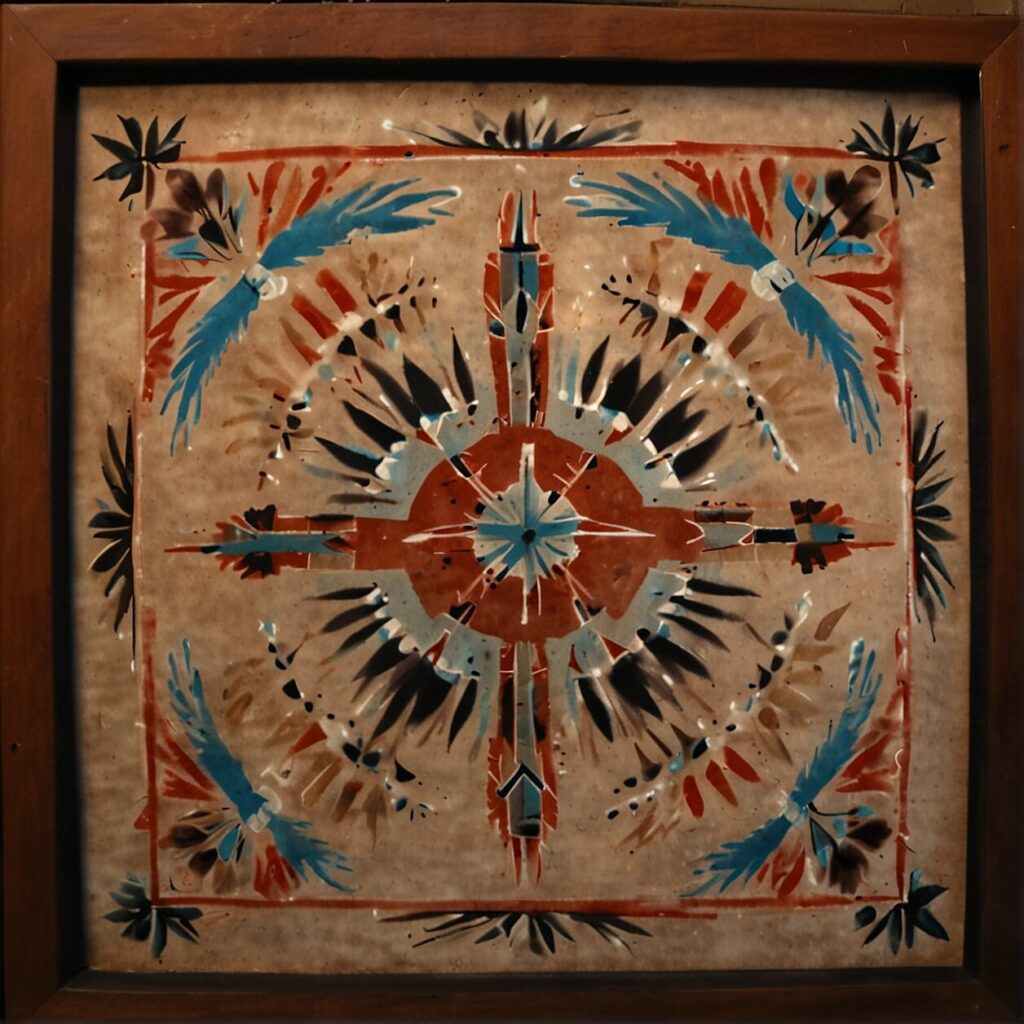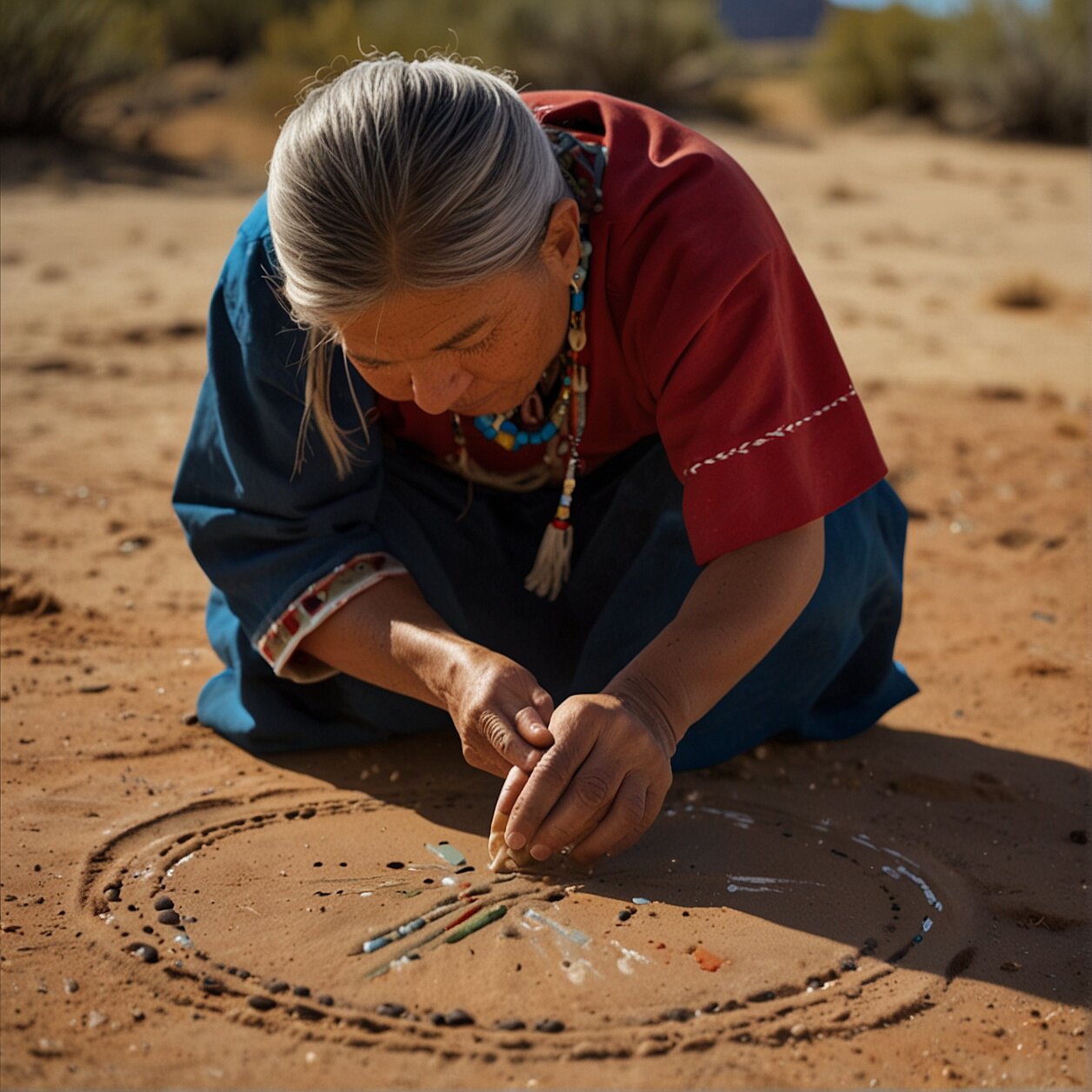Secrets of Navajo Sandpainting in the Southwest USA
Embrace the enchanting, intricate world of Navajo Sandpainting. As you delve into the awe-inspiring depths of this vibrant, colorful medium, you’ll find yourself whisked away on a journey of holistic spirituality, cultural appreciation and profound artistic expression. Navajo Sandpainting isn’t just an art form; it’s a gateway into the compelling stories, intricate patterns and symbols that define the Navajo people’s rich heritage.
- Are you captivated by the allure of deeply-rooted, spiritual traditions?
- Do you have an eye for intricate, visually stunning, handcrafted art?
- Are you intrigued by the convergence of mythology, spirituality, and culture?
If the answer to any of these questions is yes, then Navajo Sandpainting, a crowning treasure of Native American culture, beckons you to explore. Consider this your invitation to unravel the magnificent tapestry woven by the skilful hands of Navajo artists, an experience akin to walking through a dream inflated with vibrant colors and enigmatic myths.
“Art is not what you see, but what you make others see.” – Edgar Degas
Just like Degas, your journey through Navajo Sandpainting will be fueled not just by the magnificent visuals, but by what this remarkable art form makes you see, sense, and feel. Strap in, as we walk you through a virtual tour of the spiritual world of Navajo Sandpainting.
Journey into the Sacred: The Spiritual Significance of Navajo Sandpainting
Take a moment and imagine this. Delicate and colorful images taking shape on the ground created, by the careful placement of finely crushed stone. This is the sacred art of Navajo Sandpainting, an astounding testament to the immense spirituality and history of the Navajo people. Unlike other art forms that might exist primarily for aesthetic pleasure, for the Navajo, sandpaintings serve as sacred bridges to restore health and harmony.
Think of these sandpaintings as living entities, continually transforming physical and mental states. The Navajo believe these dynamic pieces don’t just reflect their ancient mythology; they breathe life into their past, bringing sacred mountains, visions, dances, and chants to the present moment. There is an intrinsic capability in every stroke and color, embodying a symbolic representation of stories from their rich mythos.
And the power of these sandpaintings does not end here. They bridge time and space, indicating a sacred place where the present and the mythic past coexist. These powerful works of art merge the earthly realm with the realm of the Holy People, attracting their healing power. It is believed that the figures represented in Sandpaintings conduct an ethereal dialogue between the Navajo and their gods, offering a profound, spiritual dimension to the art.
Marvel again at this fact: these sacred artworks, also addressed as dry paintings, are considered to be transient between the earthly and spiritual planes, acting as passages through which the gods tread, interact, and dissolve. As such, Navajo Sandpainting stands as an art form deeply rooted in spirituality, offering an extraordinary glimpse into the world of one of America’s oldest cultures.

Mastering the Art: The Process Behind Navajo Sandpainting
Imagine holding the grains of time in your hands — that’s what engaging in the art of Navajo sand painting feels like. Before the first grain of sand touches the canvas, the preparatory rites of prayer and fasting are completed, emphasizing the sacred bond the Navajo people share with all natural elements. The creation of these designs is just as important as the final piece itself, imbued with a harmonizing reverence that flows through each step of the process.
The sand painter starts by sketching a rough design in the sand bed, outlining the elements of the piece. The Navajo work from the inside out, each stroke and curve revealing a deeper layer of the mythic world they are bringing into existence. The sand used spans a naturally occurring color palette, each color with its distinct meaning and significance. The base colors are white, blue, yellow and black, symbolizing the Four Sacred Mountains in the Navajo tradition. Other hues come from a variety of materials found within traditional Navajo lands, such as gypsum, ochre and charred oak.
In Navajo sand painting, patience isn’t just a virtue, it’s a prerequisite. Each figure, whether intended to depict sacred mountains, or the dance of deities, requires an intense focus and dedication. As the sand painter manipulates the colored grains, they evoke the dynamic, living energy the Navajo believe reside within each element, conjuring a spiritual domain where myth and reality become beautifully intertwined.
The ephemeral nature intrinsic to Navajo sand painting only serves to underscore the sacredness of the practice. Post ceremony, the artwork is promptly disassembled, returning its sacred components back to nature. The visual narrative woven by these gifted painters may seem fleeting at first glance, but each stroke, each syllable of color, resonates through time and space, reverberating an enduring testament to Navajo cultural heritage.
So next time you behold the intricate beauty of a Navajo sand painting, remember: you’re not just seeing a delightful piece of art. You’re peering into the heart of Navajo culture, of stories whispered from generation to generation, an homage to the past and a potent channel for healing energies.
Tools of the Trade: What You Need for Navajo Sandpainting
Embarking on the journey of Navajo Sandpainting, you might be wondering what tools are essential to create these spiritual masterpieces. The materials employed by the Navajo in sandpainting often hold deep cultural and spiritual connotations.
The base foundation of these remarkable works is naturally colored sand. This isn’t your average beach sand, though. It’s created specifically by crushing rocks sourced from within the traditional boundaries of Navajo land, ensuring an authentic touch to every stroke. Imagine each grain carrying with it the memory and power of an ancestral homeland.
Beyond sand, other materials used are equally remarkable and symbolic. For example, white fragments come from gypsum – a mineral abundant in the American Southwest‘s crust. Yellow fragments are sourced from ochre, which is related to the earth and symbolizes the sacred East Mountain in Navajo tradition. Sandstone offers a vibrant red, while a blend of pulverized charcoal and gypsum creates a compelling blue shade. Burnt scrub oak, through a process of careful and respectful collection, is used for black segments. This careful hand-selection of colors and materials is an act both practical and symbolic for the Navajo, relating back to the Four Sacred Mountains in their tradition.
The Navajo also respectfully incorporate natural elements, such as pollen and crushed flower petals, intensifying the spiritual symbolism behind every sandpainting. Through these humble materials, they embody the deeper connections between the natural world and our human experiences.
Remember: Though you can appreciate and learn from the process behind Navajo sandpainting, it’s important to recognize its spiritual significance and respect the cultural roots of this Native American art form. It’s more than an art or craft—it’s a living tradition that bridges physical and metaphysical realms.
Next time you look upon a Navajo sandpainting, take a moment to appreciate the depth and symbolism tucked away in every grain. This is not just an aesthetic endeavor, but a spiritual journey crafted with reverence and deep understanding of Navajo cultural ethos.
Preserving Sacred Traditions: The Role of Navajo Sandpainting in Native American Culture
As you delve deeper into the tapestry of Native American culture, you may wonder about the role that sandpainting plays. For the Navajo, sandpainting is not merely a maudlin ritual; it is a living entity, a marvellous fusion of faith, artistry, and healing.
Sandpainting originated in a time of cultural upheaval, transitioning from rock pictographs to sand art in the face of colonial discouragement. This transition speaks volumes about the dynamic spirit of the Navajo people. By choosing a medium that could be effortlessly erased, they prioritized their sacred rituals over the fear of their art being destroyed or misused.
They say a picture speaks a thousand words, and Navajo sandpaintings are no exception. They breathe life into Navajo mythology, rendering celestial beings and sacred mountains in vibrant hues. Through this intricate art, the distance between the present and the mythic past is overcome, bringing them into a harmonious existence.
These graphic designs do more than merely tell tales; they serve as a bastion of healing. A blend of intricate designs and the spiritual power of the Holy People make it a potent tool in Navajo healing rituals. They are seen as portals that connect the earthly realm with the divine, and it’s this connection that facilitates the healing process.
To appreciate Navajo sandpainting is to honor the phoenix-like resilience of an entire community, to bear witness to their deep-rooted spirituality, and to acknowledge the healing powers they attribute to this significant practice. As we honor the art of Navajo sandpainting, we’re preserving not just a tradition, but the spirit of a resilient culture that continues to thrive amidst adversity.

Where Art Meets Spirituality: Understanding the Symbolism in Navajo Sandpainting
As you journey deeper into the mesmerizing world of Navajo Sandpainting, you’ll unveil a spectacular blend of artistry and symbolism. Each color, each figure, and each stroke embodies a world of meaning, drawing you deeper into a mythic, spiritual tapestry. It’s a time-bending dance between the present moment and the deep, spiritual past of the Navajo people.
What makes these sandpaintings unique is their dynamic nature. The Navajo consider sand paintings not as static art pieces but as vibrant, living entities. They hold the transformative power to alter mental and physical states, making them not just works of art but instruments of healing. It’s through this intricate artistry that harmony is restored, making Navajo Sandpainting a significant component of treatment in traditional Native American medicine.
Descend into a sandpainting, and you’ll find yourself navigating a world rich in figures, sacred mountains, visions, dances, or chants. Each of these elements, carefully and thoughtfully depicted, is a symbolic representation of various stories in Navajo mythology. They act as portals where the gods come and go, according to Navajo language interpretations of these ‘dry paintings’.
The Navajo people use vivid, colorful images, creating these intricate works of art from finely crushed stone. Through these rich hues, the Navajo illustrate their graphic design prowess, especially in this unique medium used prominently in their healing rituals.
Ultimately, the power of Navajo sandpaintings lies in their ability to attract the healing power of the Holy People, as per Navajo belief. This interplay between visual depiction and spiritual significance elevates Navajo Sandpainting beyond the realms of mere artistry, creating a living, breathing nexus where art, healing, and spirituality converge.
FAQ’S
Curious to learn more? We welcome your intrigue! Let’s dive a little deeper into the world of Navajo Sandpainting with these frequently asked questions. In this section, we provide thorough and insightful answers to common inquiries. Understanding is the first step to appreciation, so don’t be shy; read on to satiate your curiosity.
What are the common themes in Navajo Sandpainting?
Embarking on a visual narrative, Navajo Sandpaintings weave together common themes of spirituality, representation of deities, stories from mythology, and homage to natural elements. These sacred motifs unlock the essence of the Navajo way of life.
Sandpaintings often depict characters from Navajo mythology like Changing Woman, Coyote, and Monster Slayer, symbolizing the interplay of divine forces in human life. The dance of these mythological figures across the canvas celebrates interconnection and maintains the balance between good and evil.
Similarly, the recurring depiction of sacred mountains is not merely a geographical signature. In fact, the four principal colors found in sandpaintings – white, blue, yellow, and black – signify the Four Sacred Mountains that border the traditional Navajo homeland. The pictorial representation of these mountains serves as a symbolic compass, guiding the Navajo community’s spiritual navigation. These paintings, thus, serve as a dynamic, living, sacred entity, embodying Navajo traditions, visions, and chants.
Sandpaintings also serve as a timeline, merging the present with the mythic past, celebrating cyclical time rather than linear. By recounting ancestral wisdom ogmented with mythological beings, these pieces create a place where the past coexists with the present, facilitating a culturally rich form of historical storytelling.
In essence, these common themes woven masterfully in Navajo Sandpaintings are brilliant illustrations of the Navajo people’s spiritual journey, epitomizing their deep connection to the cosmos and nature.
What is the significance of colors in Navajo Sandpainting?
There are deep, symbolic meanings attached to the colors used in Navajo Sandpainting, making them an integral part of this art form that goes far beyond mere aesthetics. Each color used has spiritual connotations and plays a significant role in illustrating sacred narratives.
The principal colors— white, blue, yellow, and black—represent the Four Sacred Mountains that border the traditional Navajo homeland, outlining a symbolic map that links the artistic piece directly with the surrounding environment and the spiritual world. White symbolizes Mount Blanca, located in the east; blue symbolizes Mount Taylor in the south; yellow indicates San Francisco Peak in the west, and black represents Mount Hesperus, located in the north.
Such is the importance of these colors that the materials used are painstakingly sourced from Navajoland itself. Natural elements such as gypsum for white hues, sandstone for red, and even a blend of pulverized charcoal and gypsum for blue tones are incorporated after being finely crushed. Ochre is used for yellow, while black is obtained from charcoaled scrub oak.
Besides the geographical connections, these colors also symbolize important concepts within Navajo cosmology and spirituality. White often stands for dawn and the East, blue for South and youth, yellow for sunset and West, and black for North and age. Each color carries with it distinct teachings important for Navajo culture, religion, and worldview. They are treated with respect and utilized thoughtfully, embodying a blend of aesthetic expression and devotion to cultural tradition.
The significant presence of these colors enhances the connection between the viewer, the artist, and the depicted subject matter, making each sand painting more than just a work of art, but also a portal into the cultural depths of Navajo tradition.
Where can I see Navajo Sandpaintings in person?
You have several options if you wish to immerse yourself in the rich, captivating world of Navajo Sandpainting. There are various galleries, museums, and cultural centers dedicated to displaying authentic Navajo sandpaintings. In this way, you can experience the brilliant artistry and profound spiritual symbolism embedded in these living, breathing canvases.
One such place is the Navajo Nation Museum located in Window Rock, Arizona. This museum houses an extensive collection of Navajo and other native artwork, including sandpaintings. The Heard Museum in Phoenix, Arizona also features some stunning examples of Navajo art.
Other noteworthy venues include the Museum of Northern Arizona in Flagstaff and the Pueblo Grande Museum and Archaeological Park in Phoenix. These museums offer comprehensive displays of Native American art with a particular focus on works from the Southwest, including Navajo sandpaintings.
If you’re fortunate enough to be invited, it is also possible to observe this enchanting, transcendent art form in person during a Navajo healing ceremony. However, as these ceremonies are sacred and integral to Navajo culture, it’s important to show utmost respect and sensitivity.
Finally, participating in cultural festivals and fairs on the Navajo Reservation can be another avenue to behold these beguiling masterpieces firsthand. Tools of this intricate, spiritual art, such as naturally colored sand made from crushed rocks within the traditional boundaries of Navajoland, are used to create mesmerizing pieces live at these events.
It’s a humbling and awe-inspiring experience, getting up close with Navajo Sandpainting, where past and present merge, and art and spirituality intertwine.
Can I purchase authentic Navajo Sandpaintings, and if so, where?
Yes, you can certainly purchase authentic Navajo Sandpaintings, but you must be cautious about where you procure these sacred items. Several Navajo artists sell their unique sandpaintings through art galleries located within the Navajo reservation or nearby towns. The artists could also sell them directly at local fairs and markets such as the famous Santa Fe Indian Market, or through trusted online platforms.
However, it is crucial to remember the deep spiritual significance these artworks hold for the Navajo people. Purchasing a sandpainting is not the same as buying a simple decoration for your living room. These are sacred art forms infused with ancient knowledge, culture, and spiritual beliefs. So, if you wish to own a Navajo Sandpainting, respect for the artwork and the culture it represents should be at the heart of your purchase.
Finally, it’s important to note that traditional ceremonial sandpaintings are not made to be sold or preserved. So, true ceremonial Navajo Sandpaintings are not available for purchase, the ones for sale are adapted versions. The sandpainting you buy is much more likely to be specially designed to be portable, resilient, and suitable for exterior display. Even these adaptations carry a strong essence of Navajo spirituality and remain authentic expressions of this ancient art form.
How is Navajo Sandpainting preserved or documented for future generations?
You may wonder how such intricate yet temporary forms of art like Navajo sandpaintings can be carried forward to future generations. Traditionally, Navajo sandpaintings were ephemeral, created for specific healing rituals and ceremonially destroyed afterward, but with the passage of time and the shift in traditions, newer methods have come into play.
Modern Navajo artists have innovated ways to ensure the preservation of these sacred narratives and intricate artistry. One of the most practiced methods is permatization— the act of transforming the art from transitory sand paintings to permanent weavings and prints. This not only allows for the preservation of the story that is depicted in the sandpainting but also opens up avenues for these artworks to be sold, creating an additional income stream for the Navajo people.
Another method includes documentation through photography and videography. These forms of digital preservation have empowered the Navajo community to maintain an archive of sandpaintings, thus preserving the narratives for future generations. This has also allowed a broader audience to learn about and appreciate this beautiful heritage, sparking greater interest in Navajo culture and spirituality.
Whether through permatization or digital documentation, efforts towards preserving Navajo sandpainting ensure that this ritualistic art form continues to thrive and inspire, making it an everlasting beacon of Navajo culture. So, while you now understand the preservation methods, it’s essential to remember the intrinsic value of sandpainting, evoking an intimate bond between the community’s present life and mythical past.







